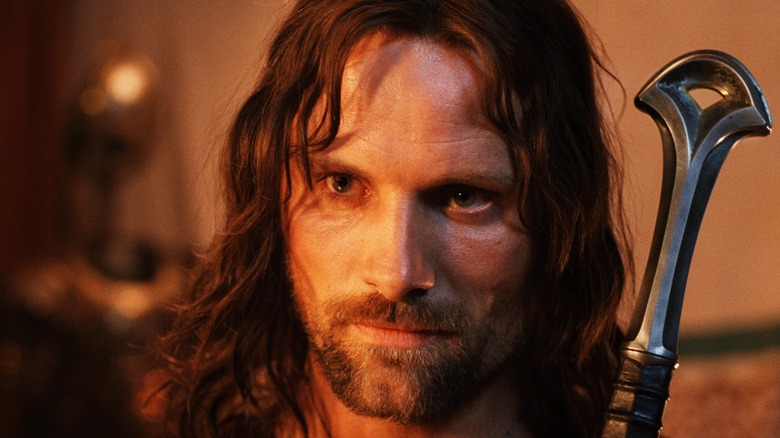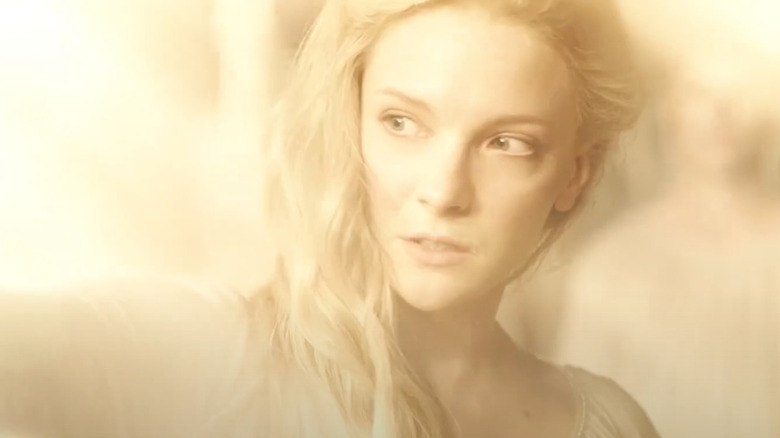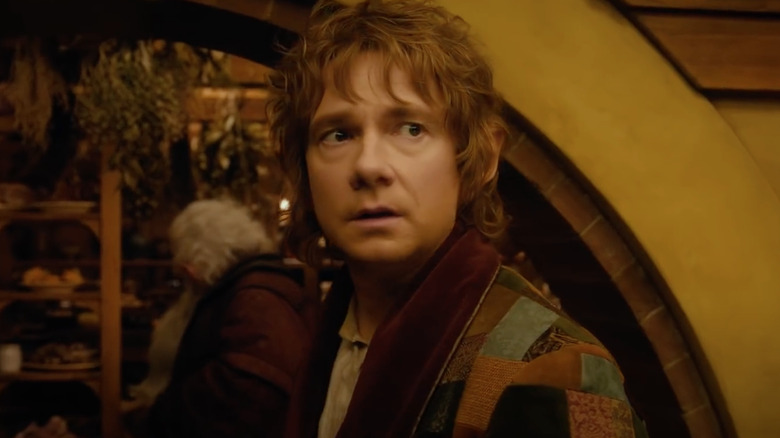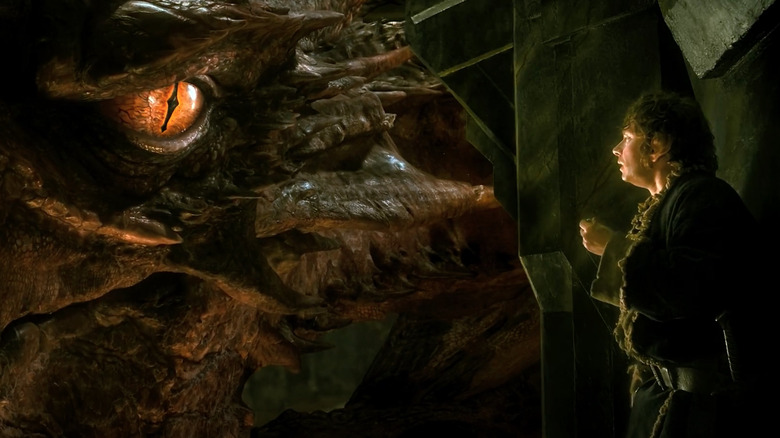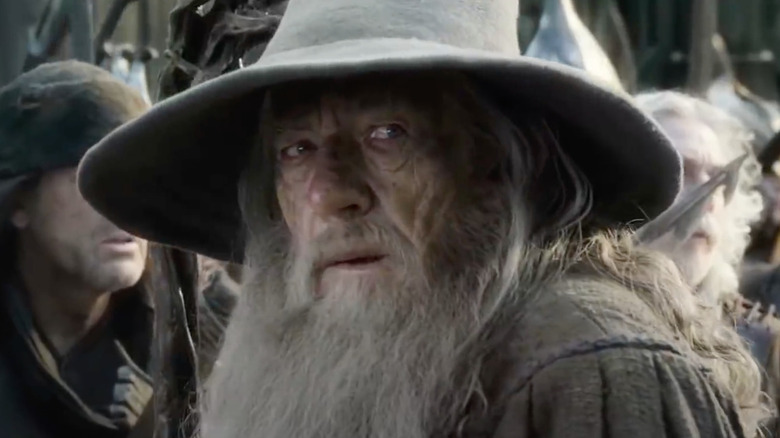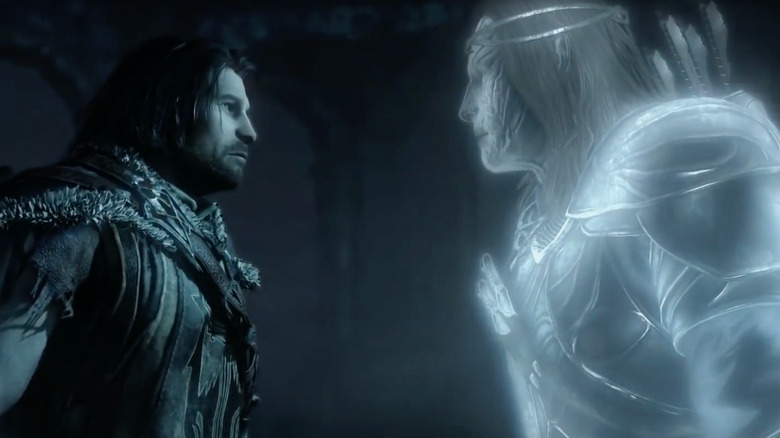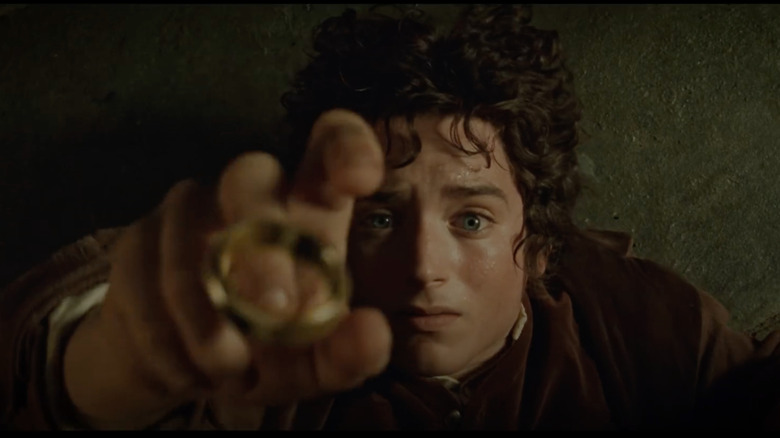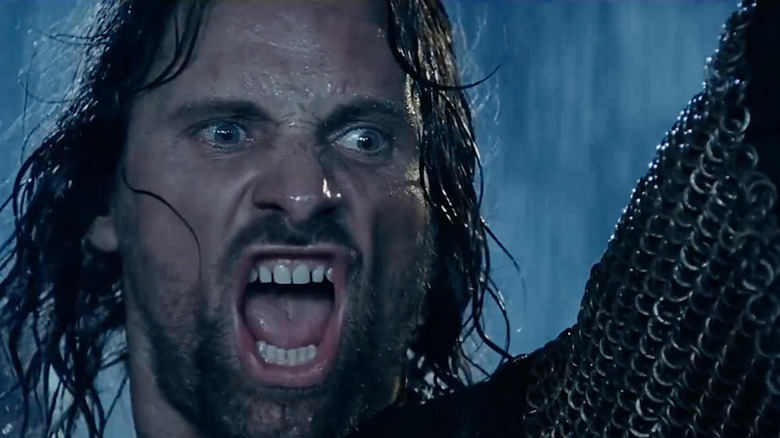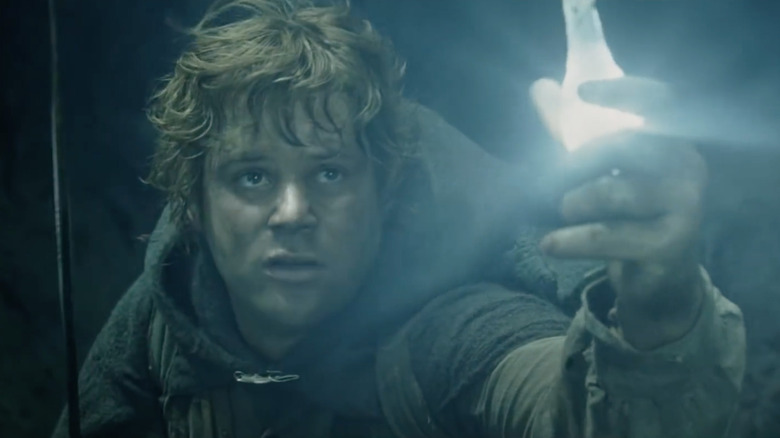This Is The Correct Order In Which To Watch The Lord Of The Rings Franchise
Peter Jackson's "Lord of the Rings" exploded onto cinema screens more than two decades ago, but remains a pop culture mainstay thanks to its wondrous visuals, delightful characters, awesome spectacle and incredible ambition. In this case, the oft-used phrase, "They don't make 'em like this anymore," certainly applies, as few big budget motion pictures have matched the epic scope of Jackson's Academy Award-winning opus.
The success of the "Lord of the Rings" trilogy, which consists of "Fellowship of the Ring," "The Two Towers" and "Return of the King," paved the way for more stories set in J.R.R. Tolkien's Middle-earth. Indeed, Jackson would eventually return to direct an ambitious three-film adaptation of "The Hobbit" ("An Unexpected Journey," "Desolation of Smaug" and "The Battle of the Five Armies"), all of which would become box office hits, even if they failed to leave the same impact as the previous trilogy. Amazon Studios then brought forth their own "LOTR" adventure with the prequel series "The Rings of Power," a billion dollar production that chronicles the events that ultimately set the war of the ring in motion.
Coupled with the Tolkien texts, that's a lot of content, encompassing a lengthy, complex timeline. Attempting to sort it all out could leave a person crazier than Smeagol. Have no fear, because here is the correct order in which to watch the "Lord of the Rings" franchise.
The Rings of Power offers a fun intro to Middle-earth
First things first: despite making its debut over 20 years after the "Fellowship of the Ring" film, Amazon's "The Rings of Power" actually takes place some 6,000 or so years before the events depicted in "The Hobbit" and "Lord of the Rings," during the Second Age of Middle-earth. That would presumably make the fantasy series the perfect starting point for newbies of the epic franchise.
There's just one problem: "The Rings of Power" has a long way to go before it arrives at its conclusion. So, while the series technically offers a first foray into J.R.R. Tolkien's fantasy world, as of 2022, viewers would have to sit around and wait for the planned five seasons to conclude before moving on. That's quite a commitment, and if you haven't yet seen the Peter Jackson films, they are too good to put off for a half-decade or more.
"Rings of Power" offers an intriguing look at characters such as Galadriel (Morfydd Clark) and Elrond (Robert Aramayo), centuries before their appearance in Jackson's epic series. Here, Galadriel is a mighty warrior whose heart and mind are almost entirely consumed by revenge. Her brother died fighting the evil wizard Sauron. As such, she has made it her life's work to seek out "the Enemy" and vanquish him once and for all.
This Galadriel is much different from her older counterpart. It'll be interesting to see her journey, even if legal obligations prevent "Rings of Power" from acknowledging Jackson's films. Your best bet? Watch whatever "Rings of Power" episodes exist at the time you're beginning your journey, then move along.
An Unexpected Journey kicks things off
Following "Rings of Power," viewers should leap straight into "The Hobbit" trilogy, starting with 2012's "An Unexpected Journey," which is set near the end of Middle-earth's Third Age.
This film kicks off with a flash forward of sorts that introduces us to an old Hobbit named Bilbo Baggins (Ian Holm), who reflects back on an adventure he experienced years ago. You see, one random afternoon, young Bilbo (a terrific Martin Freeman) received a surprise visit from a mysterious wizard known as Gandalf the Gray (Ian McKellen) and a small group of Dwarves led by the brave Thorin Oakenshield (Richard Armitage). Said Dwarves were about to embark on a quest to reclaim a dwarvish kingdom guarded by a terrifying dragon called Smaug, and they required Bilbo's help.
"An Unexpected Journey" chronicles the first leg of that group's adventure, which sees them battle the usual assortment of Orcs, trolls and cave-dwelling goblins. Viewers also get their first look at Gollum (Andy Serkis), a pivotal character in later films, and will see how Bilbo obtained the One Ring; an important bit of jewelry that likewise plays a significant role in "Lord of the Rings."
Now, the confusing part here is that Jackson filmed "The Hobbit" series nearly a decade after "Lord of the Rings." So, in terms of release dates, 2001's "Fellowship" is most definitely first, but as far as timeline is concerned, "An Unexpected Journey" is technically the first entry in the beloved series.
Desolation of Smaug continues the adventure
Something you may have gathered when watching "An Unexpected Adventure" is that Peter Jackson likes to paint on a massive canvas. That first entry clocked in at a bladder-busting 170 minutes, a characteristic that either hampers or enlivens the viewing experience, depending on your point of view. Oh, and just wait until you see the extended cuts!
After taking a bathroom break, pop in "Desolation of Smaug," which is slightly shorter than its predecessor, but no less overindulgent. While the action is fierce and mostly exciting, particularly a sequence in which Bilbo and his companions escape down a river in barrels while a violent battle between Elves and Orcs occurs on the shores around them, "Smaug" ultimately crumbles under its own weight. There's far too many characters stuck in subplots that go nowhere, and the over reliance on CGI spectacle and goofy humor conjures nightmarish flashbacks to George Lucas' "Star Wars" prequels.
Still, there's plenty to admire here. For one, Gandalf's quest to seek out Sauron is a pretty great side quest that effectively establishes dangers that will move to the foreground in "Lord of the Rings." While the fully CGI Smaug (Benedict Cumberbatch) is well worth the price of admission, even if the campy villain overstays his welcome by about 30 minutes.
Ultimately, there are far worse ways to spend nearly three hours of your life, but "Smaug" feels more like a routine pitstop than an essential piece of the larger adventure.
Battle of the Five Armies sets up the next series
Arriving at the grand finale of Peter Jackson's "Hobbit" trilogy, "Battle of the Five Armies" is just that: an enormous battle between five indistinguishable armies, whose purpose in the film is never made sufficiently clear.
Despite its heavy-handed storytelling, "The Hobbit" trilogy is ultimately just an excuse for Jackson to indulge in more grotesque, fantasy violence. If that's your thing, the man doesn't disappoint. While occasionally thrilling and beautifully rendered (aside from some dodgy CGI here and there), the cartoonish spectacle eventually grows tiresome, if not downright tedious.
High points include Gandalf's continued quest to find and destroy Sauron. This time, he's aided by Galadriel and Elrond, who use their abundant power to knock the evil wizard back to Mordor where he presumably regroups in the intervening years before "Fellowship of the Ring." Viewers also see how the One Ring slowly begins to corrupt Bilbo, while OG "LOTR" characters such as Legolas (Orlando Bloom) and Saruman (Christopher Lee) are further fleshed out.
Unfortunately, nothing else in "Five Armies" is really relevant to "Lord of the Rings." In fact, Gandalf himself will dismiss the entire "Hobbit" trilogy as little more than "the incident involving the dragon" when speaking to Frodo (Elijah Wood) in "Fellowship" — which is kinda insulting now that fans can watch all these movies in order, as that line is essentially Gandalf telling the viewer that you've just wasted 513 minutes of you life. But hey, the good news is that things really pick up from here.
BONUS: Shadow of Mordor/War
As a sidebar, at this point it would be fun to check out the "Shadow of Mordor" video game series, as its events take place during the 60-year interim between "The Hobbit" and "Fellowship of the Ring." Players control a Gondorian Ranger named Talion, who bumps shoulders with familiar faces such as Gollum and Celebrimbor (a character that figures prominently in "Rings of Power") en route to avenge loved ones who died by Sauron's hand.
Oh, and the game continues the "LOTR" tradition of killing hundreds of Orcs, sometimes in the most ghastly ways imaginable.
While "Shadows of Mordor" does deviate slightly from established mythology in order to craft its own storyline, the adventure looks and feels very much like the Peter Jackson films, making it a sort of distant cousin to the franchise (think "Shadows of the Empire"). Then, if you're feeling really adventurous, you can check out its sequel, "Shadows of War," which continues Talion's quest and expands the storyline in some neat directions. It's not always flawless, and the Orc-bashing does indeed grow tiresome after a while, but there's enough action and narrative details to make the experience worthwhile.
Fellowship of the Ring sets up the Battle for the Ring
Now that we're done with "The Hobbit" fluff, we finally arrive at perhaps the greatest film trilogy of all time: "The Lord of the Rings."
Not enough can be said about this astonishing franchise, perhaps the most ambitious undertaking in the history of film. At the time of its release, the trilogy was considered a huge gamble for all involved. Peter Jackson was a low budget horror filmmaker with a spotty background — the terrific "Heavenly Creatures" had been a critical hit, and "The Frighteners" a box-office dud — and now New Line Cinema was seemingly risking its entire studio on him producing three massive films back-to-back-to-back, armed with an eye-popping $282 million budget and an insane production schedule.
Against all odds, Jackson released the first of his planned trilogy in December of 2001 — "Lord of the Rings: The Fellowship of the Ring." Somehow, the film surpassed even the highest of expectations, going on to become a critical and commercial hit.
While more of a slow burn than "The Hobbit" films, "Fellowship" does an exceptional job establishing Middle-earth and the plucky heroes residing within. The story centers around Frodo (Elijah Wood), a young Hobbit who inherits a mysterious ring from his Uncle Bilbo that turns out to be the One Ring teased in the preceding chapters. With help from an assortment of various races — Hobbits, Elves, Dwarves and men — Frodo begins the long trek to Mount Doom, where he must destroy the ring and its master Sauron, once and for all.
The Two Towers establishes the world of men
Where "Fellowship" introduced audiences to Middle-earth via a carefully crafted story that leaned hard on character, "The Two Towers" hits the ground running, delivering the kind of swashbuckling action that would become a staple of the franchise.
With the Fellowship broken, the story splinters into three separate adventures and bounces back and forth between the efforts of Aragorn (Viggo Mortensen), Gimli (John Rhys-Davies) and Legolas to save Merry (Dominic Monaghan) and Pippin (Billy Boyd) from an army of Orcs, and Frodo and Sam's (Sean Astin) quest to reach Mount Doom to destroy the One Ring. Along the way, the heroes encounter an assortment of colorful supporting characters, the most impressive being Gollum — a creature whose entire being is tied to the ring. As portrayed by Andy Serkis, Gollum is an astonishing, fully CGI creation that puts most modern visual effects to shame (all these years later, the debate still rages on about whether Serkis should have received an Oscar). He's a tragic figure to fear and pity in equal measure, adding complexity to both his character and the story as a whole.
But "Two Towers" mostly focuses on Aragorn's attempts to fulfill his destiny and claim his rightful place as King of Gondor. Viggo Mortensen delivers a star-making performance, all but shouldering the bulk of "Two Towers" until its thrilling, climactic finale in which men, Elves and Dwarves square off against an army of Orcs in the Battle of Helm's Deep; one of the great action sequences in cinema history.
Return of the King concludes the franchise
With the pieces set in place, Peter Jackson closes his original "LOTR" trilogy with an all-time classic, "Return of the King."
As Frodo, Sam and the treacherous Gollum near Mount Doom, their quest to destroy the One Ring grows more precarious. The trio encounter all manner of obstacles in the last leg of their journey (including a giant spider called Shelob), but also contend with one another as a result of the One Ring's corruptible power. Elsewhere, Gandalf and Pippin battle Sauron's forces at Minas Tirith, while Aragorn, fresh from his victory at Helm's Deep, heads off with the ever loyal Legolas and Gimli to seek reinforcements. All three storylines converge at Mount Doom, where the series comes to an exciting, emotional climax that thrills and stirs the heart in equal measure.
Nothing could have prepared viewers for "Return of the King." Utilizing an assortment of spectacular special effects, Jackson and his team of creative artists bring the world of J.R.R. Tolkien to vivid life, producing some of the grandest battle sequences of all time. Even so, the director never loses sight of the characters or story, resulting in a film bursting with unabashed emotion. You'll probably need a box of tissues to get through this one.
"Return of the King" would go on to sell $1.1 billion in tickets and win a bevy of Academy Awards, a truly impressive feat for a fantasy film. Truly, it's the perfect end to an ambitious, amazing series.
